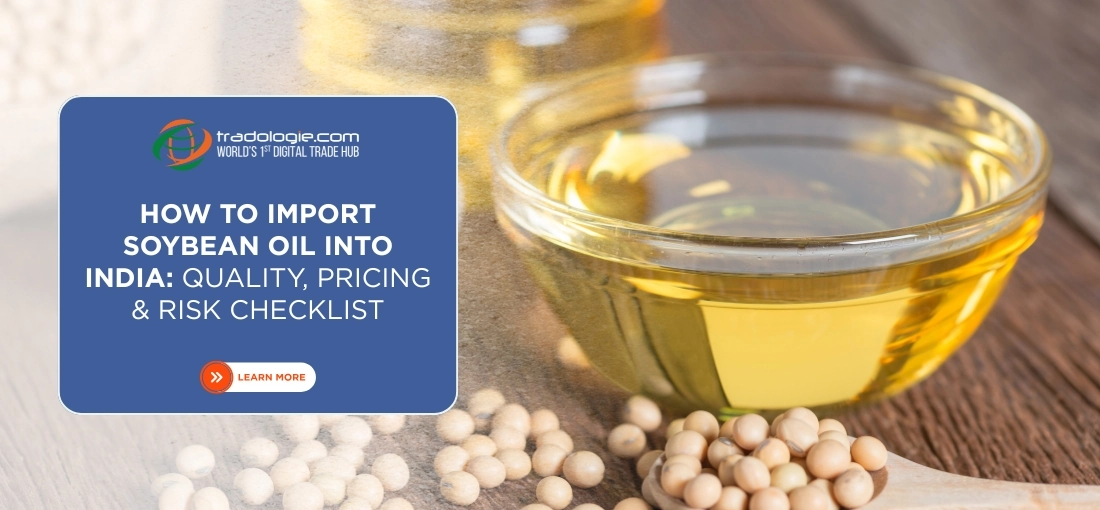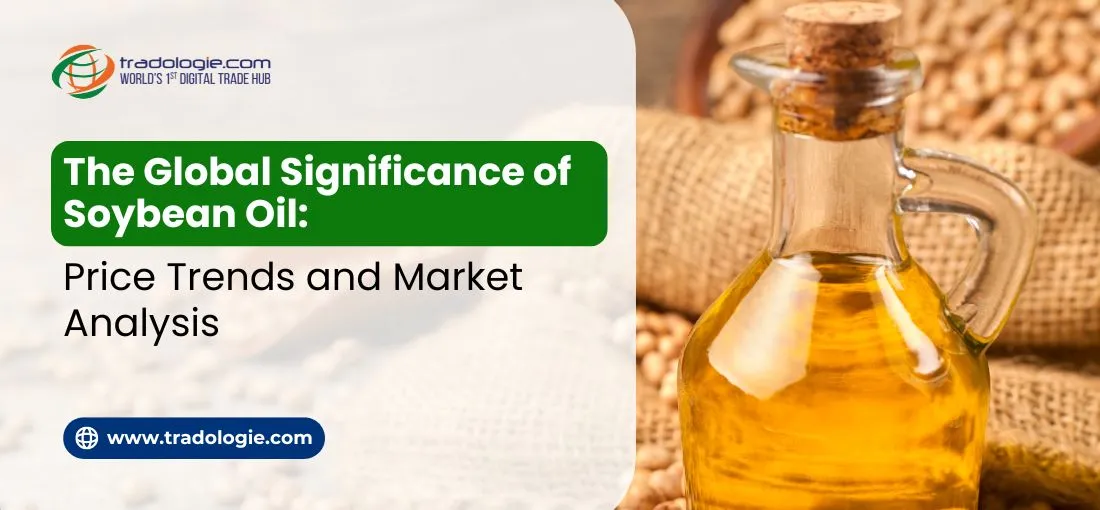How to Import Soybean Oil into India: Quality, Pricing & Risk Checklist (2025 Update)
Key Highlights:
- India imports millions of tons of soybean oil every year to meet the rising needs of households and the food industry across the country.
- Follow all FSSAI rules and make sure to get your IEC, FSSAI license, and other required certificates to ensure smooth and hassle-free import.
- Always check quality carefully by looking at free fatty acids, moisture content, peroxide levels, and proper packaging standards.
- Keep track of global oil prices, shipping costs, and currency changes to manage the total import cost efficiently.
- Use verified B2B platforms like Tradologie to connect directly with certified exporters and make your trade simple, safe, and reliable.
Introduction
Soybean oil is one of the most consumed Edible Oils in India, used widely in households, packaged foods, and the food processing industry. India's domestic production falls short to meet the demand, thus the state continues to rely heavily on imports from major producing countries such as Argentina, Brazil, and the United States.
For Soybean importers and its bulk buyers, it is important to understand the quality parameters, price trends, and risk factors, as they are essential to ensure regulatory compliance and quality standards.
India's Dependence on Soybean Oil Imports
India imports nearly 3.5 to 4 million metric tons of soybean oil annually, making it one of the top importers globally. The country's edible oil consumption rate has been rising due to several factors such as urbanization, expansion of food processing, and lifestyle changes.
India's domestic soybean output gets affected by erratic rainfall and limited crushing capacity, and cannot meet internal demand. As a result, India must source refined and crude soybean oil from top exporting countries, mainly South American.
Following are the major suppliers of Soybean oil to India:
- Argentina - World's top soybean oil exporter, providing competitively priced refined oil.
- Brazil - Supplies both crude and refined oil, meeting seasonal demand gaps.
- U.S. - Exports limited quantities but known for high-quality non-GMO soybean oil.
Understanding Import Regulations and Licensing
To import Soybean Oil into India, traders must follow the FSSAI (Food Safety and Standards Authority of India) guidelines and obtain necessary import licenses.
Key regulatory requirements include:
- Import Export Code (IEC): Issued by DGFT, mandatory for all importers.
- FSSAI License : Required for edible oil import, storage, and sale.
- Bill of Entry : Filed at customs for product clearance.
- Phytosanitary Certificate : Ensures the product is pest- and contamination-free.
- Certificate of Analysis : Specifies the quality, chemical composition, and moisture level of the oil.
Following these rules ensures customs clearance and prevents penalties or shipment rejections.
Quality Parameters for Imported Soybean Oil
Quality standards for edible soybean oil are defined under the FSSAI regulations and Codex Alimentarius (international food standards). Importers must ensure that the oil meets the following specifications:
| Parameter | Ideal Range / Requirement |
|---|---|
| Free Fatty Acid (FFA) | Max 0.25% (as oleic acid) |
| Moisture & Impurities | Max 0.1% |
| Peroxide Value | Max 10 meq/kg |
| Color (Lovibond) | Not more than 25 Yellow / 2.5 Red |
| Flash Point | Minimum 250°C |
| Odor & Taste | Neutral, free from rancidity |
| Packaging | Must be in food-grade, leak-proof containers |
Adhering to these parameters helps maintain oil freshness, flavor, and shelf life. For industrial users, the focus also includes oxidative stability and compatibility for blending.
Soybean Oil Pricing Trends (2024-2025)
Soybean oil prices are highly influenced by global crop yields, demand from China, and crude oil prices. In early 2025, international prices averaged around USD 970-1,050 per metric ton, depending on quality and origin.
Factors impacting pricing include:
- Weather Patterns: Droughts in Brazil or Argentina can tighten supply.
- Currency Fluctuations: USD-INR exchange rates directly affect landed cost.
- Freight Charges: Ocean freight volatility adds to import costs
- Export Tariffs: Changes in duties by South American exporters can shift global rates.
In India, the landed cost for crude soybean oil (CIF) usually ranges between ₹95,000 and ₹110,000 per metric ton, depending on port location and tax structure.
Risk Checklist for Soybean Oil Importers
Importing soybean oil involves multiple risks—from market fluctuations to quality issues. Traders should consider the following checklist to minimize exposure:
- Quality Risk: Always source from certified exporters with proven quality control systems. Use pre-shipment inspection agencies to verify oil parameters. For example, buying refined soybean oil from Argentina's leading producers tested by SGS or Intertek ensures low free fatty acid and peroxide values.
- Price Volatility: Hedge contracts or lock prices early, especially when global supply is tight. For instance, locking rates in December can protect against sudden price spikes caused by droughts in Brazil.
- Currency & Freight Risk: Monitor USD-INR movements and global shipping rates to plan purchases efficiently. For example, a 5% drop in the rupee against the dollar can increase landed cost, while surging ocean freight from South America adds extra charges.
- Customs Delays: Missing documents or incorrect labeling can cause long delays; ensure all certifications are in place.
- Regulatory Risk: Keep updated with FSSAI import norms and DGFT notifications to avoid compliance issues.
- Storage Issues: Improper handling can cause rancidity; ensure proper warehousing with temperature control.
Preferred Indian Ports for Soybean Oil Imports
Soybean oil enters India mainly through major coastal ports with efficient edible oil handling infrastructure:
| Port | State | Key Import Advantage |
|---|---|---|
| Kandla Port | Gujarat | Major import hub with refining and bulk storage facilities |
| Mumbai Port | Maharashtra | Ideal for western India's industrial and retail supply |
| Chennai Port | Tamil Nadu | Suitable for southern distribution. |
| Haldia Port | West Bengal | Connects eastern markets efficiently. |
| Visakhapatnam Port | Andhra Pradesh | Handles increasing South Indian demand. |
Why Use Verified B2B Platforms
Digital platforms (Agro-Commodity Trade) like Tradologie simplify the Soybean import process by connecting verified international suppliers with Indian buyers. Importers can access features such as:
- Compare live quotes from multiple exporters.
- Negotiate prices digitally in real time.
- Access quality-verified shipments and documentation support.
- Ensure transparent trade and reduced middlemen costs.
This model allows bulk soy bean buyers and its processors to manage imports efficiently while maintaining quality and competitive pricing.
Future Outlook
The Indian edible oil market is expected to grow to around USD 35 billion by 2026, with soybean oil holding the majority of the market share. With rising consumption and limited local production, importers can leverage their profits by connecting with trusted and verified international Soybean bulk.
For India soybean importers, it is critical to keep up with trade rules, buy from certified exporters, and plan price strategies to stay profitable in this dynamic global agro-commodity market.
Conclusion
Importing soybean oil into India offers good growth potential but demands careful attention to quality, pricing, and risk management. Ensuring compliance with FSSAI norms, tracking global price trends, and working with verified suppliers can help buyers minimize risks and optimize margins.
With trusted digital platforms like Tradologie.com, bulk buyers can import soybean oil securely, transparently, and at the most competitive global rates.





